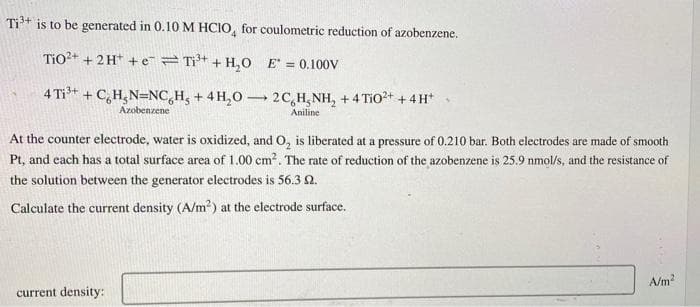Ti³+ is to be generated in 0.10 M HCIO, for coulometric reduction of azobenzene. TiO2+ + 2H+ + e Ti³¹+ + H₂O E = 0.100V 4 Ti³+ + C₂H₂N-NC H, + 4H₂O2C,H, NH₂ +4 TiO2+ + 4H+ Azobenzene Aniline At the counter electrode, water is oxidized, and O₂ is liberated at a pressure of 0.210 bar. Both electrodes are made of smooth Pt, and each has a total surface area of 1.00 cm². The rate of reduction of the azobenzene is 25.9 nmol/s, and the resistance of the solution between the generator electrodes is 56.3 2. Calculate the current density (A/m²) at the electrode surface. current density: A/m²
Ti³+ is to be generated in 0.10 M HCIO, for coulometric reduction of azobenzene. TiO2+ + 2H+ + e Ti³¹+ + H₂O E = 0.100V 4 Ti³+ + C₂H₂N-NC H, + 4H₂O2C,H, NH₂ +4 TiO2+ + 4H+ Azobenzene Aniline At the counter electrode, water is oxidized, and O₂ is liberated at a pressure of 0.210 bar. Both electrodes are made of smooth Pt, and each has a total surface area of 1.00 cm². The rate of reduction of the azobenzene is 25.9 nmol/s, and the resistance of the solution between the generator electrodes is 56.3 2. Calculate the current density (A/m²) at the electrode surface. current density: A/m²
Chapter11: Dynamic Electrochemistry
Section: Chapter Questions
Problem 10P
Related questions
Question

Transcribed Image Text:Ti³+ is to be generated in 0.10 M HCIO, for coulometric reduction of azobenzene.
TiO²+ + 2H+ e Ti³+ + H₂O E = 0.100V
4 Ti³+ + C₂H₂N-NCH, + 4H₂O2C H₂NH₂ +4 TiO2+ + 4H+
Azobenzene
Aniline
At the counter electrode, water is oxidized, and O₂ is liberated at a pressure of 0.210 bar. Both electrodes are made of smooth
Pt, and each has a total surface area of 1.00 cm². The rate of reduction of the azobenzene is 25.9 nmol/s, and the resistance of
the solution between the generator electrodes is 56.3 2.
Calculate the current density (A/m²) at the electrode surface.
current density:
A/m²
Expert Solution
This question has been solved!
Explore an expertly crafted, step-by-step solution for a thorough understanding of key concepts.
Step by step
Solved in 3 steps with 3 images

Knowledge Booster
Learn more about
Need a deep-dive on the concept behind this application? Look no further. Learn more about this topic, chemistry and related others by exploring similar questions and additional content below.Recommended textbooks for you


Principles of Instrumental Analysis
Chemistry
ISBN:
9781305577213
Author:
Douglas A. Skoog, F. James Holler, Stanley R. Crouch
Publisher:
Cengage Learning



Principles of Instrumental Analysis
Chemistry
ISBN:
9781305577213
Author:
Douglas A. Skoog, F. James Holler, Stanley R. Crouch
Publisher:
Cengage Learning



Chemistry
Chemistry
ISBN:
9781305957404
Author:
Steven S. Zumdahl, Susan A. Zumdahl, Donald J. DeCoste
Publisher:
Cengage Learning

Chemistry: An Atoms First Approach
Chemistry
ISBN:
9781305079243
Author:
Steven S. Zumdahl, Susan A. Zumdahl
Publisher:
Cengage Learning